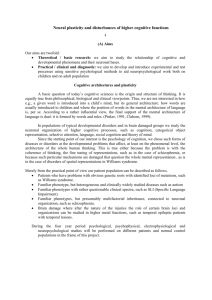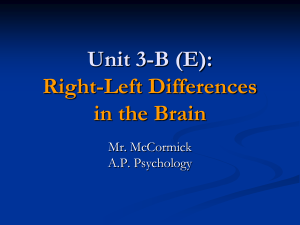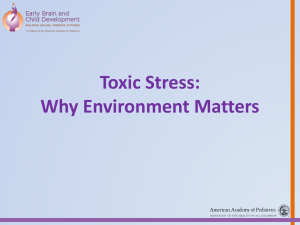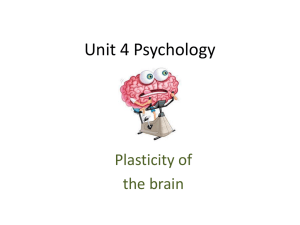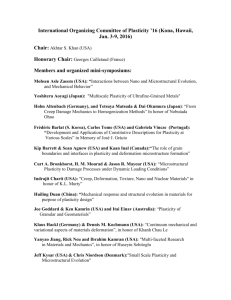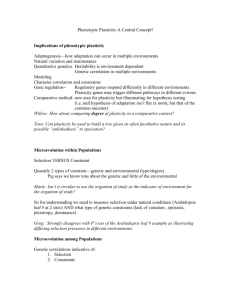Sensitive Periods in Brain Development
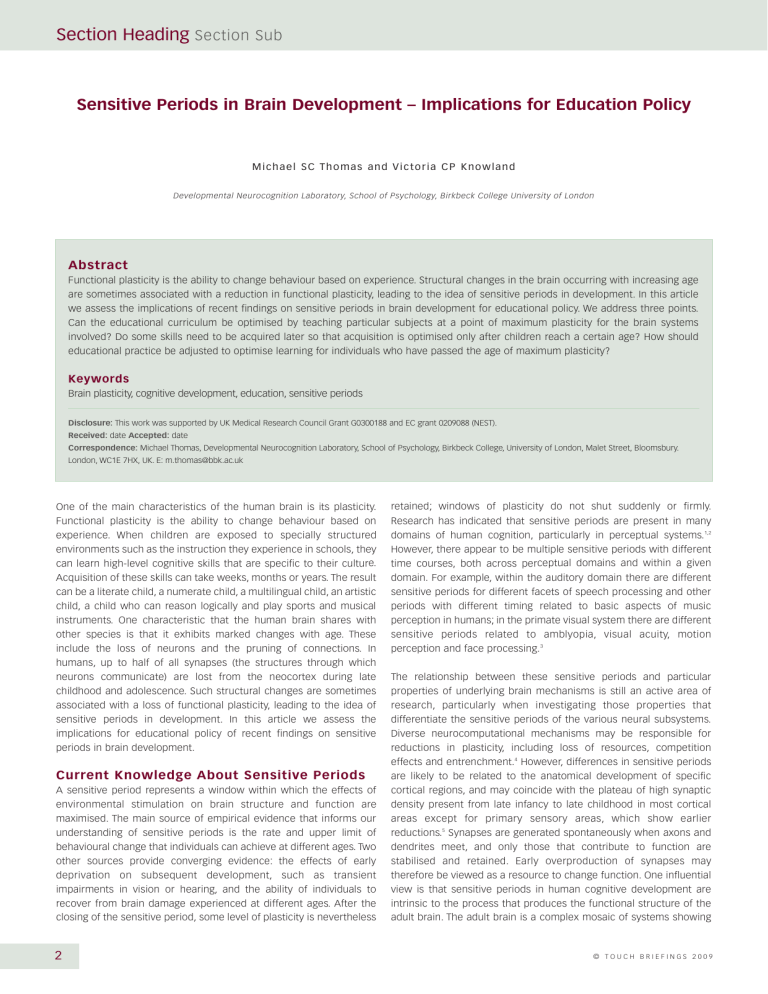
Section Heading Section Sub
Sensitive Periods in Brain Development – Implications for Education Policy
M i c h a e l S C T h o m a s a n d V i c t o r i a C P K n o w l a n d
Developmental Neurocognition Laboratory, School of Psychology, Birkbeck College University of London
Abstract
Functional plasticity is the ability to change behaviour based on experience. Structural changes in the brain occurring with increasing age are sometimes associated with a reduction in functional plasticity, leading to the idea of sensitive periods in development. In this article we assess the implications of recent findings on sensitive periods in brain development for educational policy. We address three points.
Can the educational curriculum be optimised by teaching particular subjects at a point of maximum plasticity for the brain systems involved? Do some skills need to be acquired later so that acquisition is optimised only after children reach a certain age? How should educational practice be adjusted to optimise learning for individuals who have passed the age of maximum plasticity?
Keywords
Brain plasticity, cognitive development, education, sensitive periods
Disclosure: This work was supported by UK Medical Research Council Grant G0300188 and EC grant 0209088 (NEST).
Received: date Accepted: date
Correspondence: Michael Thomas, Developmental Neurocognition Laboratory, School of Psychology, Birkbeck College, University of London, Malet Street, Bloomsbury.
London, WC1E 7HX, UK. E: m.thomas@bbk.ac.uk
One of the main characteristics of the human brain is its plasticity.
Functional plasticity is the ability to change behaviour based on experience. When children are exposed to specially structured environments such as the instruction they experience in schools, they can learn high-level cognitive skills that are specific to their culture.
Acquisition of these skills can take weeks, months or years. The result can be a literate child, a numerate child, a multilingual child, an artistic child, a child who can reason logically and play sports and musical instruments. One characteristic that the human brain shares with other species is that it exhibits marked changes with age. These include the loss of neurons and the pruning of connections. In humans, up to half of all synapses (the structures through which neurons communicate) are lost from the neocortex during late childhood and adolescence. Such structural changes are sometimes associated with a loss of functional plasticity, leading to the idea of sensitive periods in development. In this article we assess the implications for educational policy of recent findings on sensitive periods in brain development.
Current Knowledge About Sensitive Periods
A sensitive period represents a window within which the effects of environmental stimulation on brain structure and function are maximised. The main source of empirical evidence that informs our understanding of sensitive periods is the rate and upper limit of behavioural change that individuals can achieve at different ages. Two other sources provide converging evidence: the effects of early deprivation on subsequent development, such as transient impairments in vision or hearing, and the ability of individuals to recover from brain damage experienced at different ages. After the closing of the sensitive period, some level of plasticity is nevertheless retained; windows of plasticity do not shut suddenly or firmly.
Research has indicated that sensitive periods are present in many domains of human cognition, particularly in perceptual systems.
1,2
However, there appear to be multiple sensitive periods with different time courses, both across perceptual domains and within a given domain. For example, within the auditory domain there are different sensitive periods for different facets of speech processing and other periods with different timing related to basic aspects of music perception in humans; in the primate visual system there are different sensitive periods related to amblyopia, visual acuity, motion perception and face processing.
3
The relationship between these sensitive periods and particular properties of underlying brain mechanisms is still an active area of research, particularly when investigating those properties that differentiate the sensitive periods of the various neural subsystems.
Diverse neurocomputational mechanisms may be responsible for reductions in plasticity, including loss of resources, competition effects and entrenchment.
4 However, differences in sensitive periods are likely to be related to the anatomical development of specific cortical regions, and may coincide with the plateau of high synaptic density present from late infancy to late childhood in most cortical areas except for primary sensory areas, which show earlier reductions.
5 Synapses are generated spontaneously when axons and dendrites meet, and only those that contribute to function are stabilised and retained. Early overproduction of synapses may therefore be viewed as a resource to change function. One influential view is that sensitive periods in human cognitive development are intrinsic to the process that produces the functional structure of the adult brain. The adult brain is a complex mosaic of systems showing
2
© T O U C H B R I E F I N G S 2 0 0 9
Sensitive Periods in Brain Development – Implications for Education Policy
considerable specificity in their functional properties. Under the
Interactive Specialisation theory, this mosaic is the outcome of a process of increasing specialisation or fine-tuning of response properties across development.
3,6 There is a gradual change from diffuse bilateral cortical representations to more focal, unilateral activity. Brain regions with initially poorly defined response functions become increasingly restricted to a narrower set of stimuli or task demands. The termination of sensitive periods coincides with the commitment of particular regions to particular functions. Crucially, the process of emergent specialisation is experience dependent, representing the competition between different brain regions to adopt separate functions. The implication is that changes in plasticity are in part driven by learning itself rather than occurring according to a predetermined schedule.
7,8 least at the behavioural level 10 in the ability to represent new meanings; that is, in the semantics of the language system.
17
A more general lesson regarding education and sensitive periods is that the abilities that must be put in place early are the relevant perceptual discriminations on which later academic skills rely. Animal studies indicate that exposure to the sensory stimuli may be sufficient to induce these discriminations, even if the initial behavioural skills exhibited are fairly restricted, because there may be other developmental factors limiting behavioural expression, such as motor development.
18,19 It is not clear whether exposure requires instruction within a structured learning environment at a young age, or whether motivated exploration of the stimuli is sufficient. However, there is some risk that if early exposure is not followed up by continued use, skills will be lost.
Three additional findings are noteworthy. First, sensitive periods may help later learning. For example, human infants show specialisation to perceiving the speech sounds of their native language at around 12 months of age, with a corresponding reduction in the ability to distinguish between the speech sounds of incompatible foreign languages. Kuhl and colleagues found that infants who showed reduced ‘neural commitment’ to the sounds of their native language subsequently showed poorer language development over the next two years.
9 Notably while making a neural commitment is associated with reduced plasticity, the reduction in plasticity is gradual and some level of plasticity is typically retained.
10 However, behavioural change may require more attention and motivation thereafter. Second, although sensitive periods differ across brain systems, a broad pattern has been discerned: lower-level systems appear to reduce their plasticity before higher-level systems.
5,11 Moreover, for some systems, no sensitive periods have been observed (e.g. the somatosensory cortex). Third, some researchers have speculated that the abilities and associated brain regions that show the most extended plasticity may also be those that are most vulnerable to damage in development.
12 For example, the magnocellular pathway shows extended plasticity, and impairments of this pathway have been implicated in developmental dyslexia, 1 with the dorsal stream showing a more general vulnerability.
13
Which Skills Need to Be Taught Early?
An educational curriculum would be optimised if the age at which each academic subject or skill coincided with the period of maximum plasticity for the brain systems involved. From the preceding section, two immediate limitations are evident. If changes in plasticity occur in part due to experience rather than according to a fixed schedule, the point of maximum plasticity may not correspond to a single age.
Second, the high-level cognitive skills targeted in education usually involve the integration of many lower-level systems, but the sensitive periods of these systems may be different. For example, plasticity in acquiring new languages is likely to be the combinatorial result of the relative plasticity of underlying auditory, phonological, semantic, syntactic and motor systems combined with the developmental interactions between these components. Research suggests that the limiting factor when children and adults attempt to learn languages later in life is an attenuated ability to distinguish the component sounds (or in the case of sign language, hand shapes) of the language.
14 Impairments in morphology and grammar are less marked.
1,15,16 Such impairments are perhaps contingent on difficulties representing the input signal, which then affect the computations that must be carried out on this signal. There may be no reduction at all (at
Although the idea of sensitive periods has been influential in the history of education, 20 little empirical evidence has accrued showing that there are sensitive periods in the acquisition of high-level skills such as literacy and numeracy so long as the component sensory and motor abilities have developed normally. Elimination of synapses occurs earliest in primary sensory areas and later in the regions of parietal and temporal cortex implicated in sensory integration, language processing, mathematical abilities and musical abilities.
5 However, both literacy and numeracy illustrate how learning itself can reduce subsequent functional plasticity. Both literacy and numeracy represent cases where extended instruction serves to integrate existing sub-systems into a novel functional structure. In the case of reading, the visual system must be integrated with the existing spoken language system. In the case of numeracy, at least three systems must be integrated: 21 an attentional system for tracking a small number of objects in parallel, a system for representing analogue magnitudes and a language-based system for representing number words, sequences and facts (such as times tables). In reading, dyslexia often stems from problems representing the speech sounds of language
(phonology). To maximise protection against dyslexia in children at risk of the disorder, researchers have found that problems with phonology need to be alleviated before children learn to read.
22
Once the child starts to learn associations between written letters and bad phonology, this learning is harder to undo.
23 Similarly, in numeracy children build the number words of their first language into the emerging number system. Once this system is formed, if children learn a subsequent language the previous language cannot be readily ‘unplugged’ from its role in encoding number facts – adult bilinguals generally find they have to resort to their first acquired language for mental arithmetic.
24
Which Skills Need to Be Taught Later?
Do some skills need to be acquired later so that acquisition is optimised only after children reach a certain age? It has been shown that many educationally relevant behaviours can be advanced before they would normally be expected to emerge in school, from early home experiences promoting reading development prior to starting school 25 to enhancing executive functioning in children as young as three years of age.
26 Such training has resulted in the establishment of more focal patterns of neural activity 27 that parallel longitudinal patterns of change in children not exposed to intense input.
28
However, if the goal of education is to achieve the highest point of
E U R O P E A N P S Y C H I A T R I C R E V I E W
3
Section Heading Section Sub
proficiency as efficiently as possible, it is not enough simply to demonstrate that training can induce skills at a younger age. First, a number of studies looking at early training have found that it is more effective for slightly older children. For example, early phonological awareness training in American kindergarten children was found to be more advantageous for children nearer the first-grade cut-off point than for their younger peers.
29 When Rueda et al.
27 taught attention skills to children who were four and six years of age, they found that while both groups benefited from training, only the six-year-old group showed specific development of executive attention skills and corresponding adult-like event-related potential brainwave signatures. Second, advances produced by early training are sometimes lost, simply because children who did not experience the training catch up. For example, it has been shown that the early academic benefits of a highly didactic pre-kindergarten environment were lost as early as the kindergarten year.
30 Third, enrichment programmes have been found to be more effective in children from lower socioeconomic backgrounds raised in impoverished environments, with fewer benefits demonstrated for children already exposed to a stimulating environment.
need to be altered, for instance to highlight particular properties of the task domain that are important for performance.
Second-language acquisition provides one example.
Where individuals miss the sensitive period for learning the phonetic categories of a given language, the principles of repetition, feedback, intermittent reactivation 38 and incremental learning 39,40 have been shown to result in the most dramatic and durable effects in adults.
One important strategy for perceptual category learning is to initially exaggerate the distinctions between inputs such as non-native phonemes and then incrementally reduce the distinctions to bring them in line with realistic phonemes. Less is known about optimal training principles beyond low-level perceptual systems. One recent suggestion is that high-level systems such as executive functions may respond best to incremental increases in complexity, where task demands are kept just above the level at which the learner is operating.
37
The key to optimal educational outcomes is not teaching as much as possible as early as possible. However, two principles are emerging that indicate how to put in place stable building blocks that can positively effect later learning and understanding. The first principle is that learning skills in the correct order is often more important than the exact age at which these skills are learned. Within the constructivist framework, 31 more complex or abstract skills are built on top of simpler, perceptually driven knowledge. Attempts to instruct children in abstract skills (such as reasoning) may falter not because these children are too young but because the more basic foundations have not been put in place (such as relevant knowledge). Constructivist approaches to cognitive development have recently been combined with theories of brain development within the framework of neuroconstructivism.
32
Within this framework, a number of models looking at changes in cortical plasticity invoke the idea of ‘cascades’ or ‘waves’ of plasticity, where each level of processing depends on reliable and stable inputs from the level below.
3,33
The roles of motivation and attention and the use of strategy and meta-cognition are the other keys to learning new skills after putative sensitive periods have closed. While older learners can sometimes develop new skills more quickly than their younger counterparts because of the additional strategies available to them, 41 adults may require more cognitive resources to learn new skills.
7 However, it is important to stress that in most cases plasticity is reduced rather than eliminated. Learning is still possible, but it requires more effort and may produce imperfect results. Factors other than age are also important. For example, evidence from animal studies indicates that learning in a social context may be one factor that permits later learning of abilities associated with sensitive periods: when songbirds were too old to learn their song from a passive tape-recording, they could still do so from an interactive partner.
42
Conclusion
The second principle is the importance of developing skills that aid learning across all domains. Attention, for example, is a key component of academic success, which can influence the learning of skills with putative sensitive periods, such as first-language acquisition in humans.
34 It has been found that attention, along with
Sensitive periods in brain development can inform educational policy by indicating the appropriate age at which academic skills are taught.
The strongest evidence for sensitive periods in human development is in sensory systems. Educationally, this points towards early exposure for domains that rely on sensory modalities, such as language acquisition and music. These skills are likely to be more effectively acquired if learning commences in early schooling
(between five and 10 years of age). The majority of academic skills involve higher cognition, which relies on brain systems with more extended plasticity. To date, there is no strong evidence for high-level other cross-domain skills such as working memory, can be trained in very young children.
35–37 Enhancing skills such as selective and sustained attention in young school children may have longer-lasting and more noticeable effects of academic development than directly training domain-specific skills.
sensitive periods that operate to restrict learning in higher-level abilities (such as numeracy and literacy), over and above sensitive periods that produce sensory limitations. It is likely that, beyond late childhood, processes of pruning will gradually reduce spare cognitive resources if they are not utilized by a cognitively challenging environment, but behavioural change may still be available
Learning After Sensitive Periods Have Closed
An understanding of sensitive periods must also guide educational practice for teaching individuals who have passed the age when plasticity was at its maximum. To predict the best method of teaching, we need to know which mechanism is responsible for the closing of depending on levels of attention and motivation.
43 However, individual cognitive abilities form only part of the story. Learning within an educational setting relies on children possessing a wider skill set, including the ability to follow directions, the ability to the sensitive period. As we have seen, there are several candidates.
In some cases, more intense training may be necessary. In other communicate wants, needs and thoughts verbally, the ability to be enthusiastic and curious in learning and the ability to be sensitive to the feelings of other children.
44 Moreover, in parallel with cognitive cases, the context of training may need to be altered abilities, there are processes of physical, emotional, social and
(e.g. temporary cessation of competing tasks that may interfere with learning). In other cases, the nature of the training experience may sexual development, with increasing importance of the peer group on individual learning. Indeed, a recent line of research within
4
E U R O P E A N P S Y C H I A T R I C R E V I E W
Sensitive Periods in Brain Development – Implications for Education Policy
cognitive neuroscience has begun to explore how puberty may affect cognitive abilities in adolescence.
45,46 Therefore, multiple factors must be taken into account in considering the best age to engage children in specific topics within the educational curriculum.
■
1.
Neville H, Different profiles of plasticity within human cognition. In: Munakata Y, Johnson MH (eds), Attention and
Performance XXI: Processes of change in brain and cognitive development , Oxford: Oxford University Press,
2006;287–314.
2.
Thomas MSC, Johnson MH, New advances in understanding sensitive periods in brain development,
Curr Directions Psychological Sci , 2008;17(1):1–5.
3.
Johnson MH, Sensitive periods in functional brain development: Problems and prospects, Developmental
Psychobiology , 2005;46(3);287–92.
4.
Thomas MSC, Johnson MH, The computational modelling of sensitive periods, Developmental Psychobiol , 2006;48(4);
337–44.
5.
Huttenlocher PR, Neural plasticity: The effects of the environment on the development of the cerebral cortex , Cambridge, MA:
Harvard University Press, 2002.
6.
Johnson MH, Functional brain development in humans,
Nature Rev Neuroscience , 2001;2:475–83.
7.
Knudsen EI, Sensitive periods in the development of the brain and behaviour, J Cognitive Neurosci , 2004;16(8):141–25.
8.
Uylings HBM, Development of the human cortex and the concept of ‘critical’ or ‘sensitive’ periods, Lang Learning ,
2006;56(Suppl. 1):59–90.
9.
Kuhl PK, Conboy BT, Coffey-Corina S, et al., Phonetic learning as a pathway to language: new data and native language magnet theory expanded (NLM-e), Philosophical
Trans Royal Soc , 2008;363:979–1000.
10. Weber-Fox C.M, Neville HJ, Maturational constraints on functional specializations for language processing: ERP and behavioral evidence in bilingual speakers, J Cognitive
Neurosci , 1996;8(3):231–56.
11. Gogtay N, Giedd JN, Lusk L, et al., Dynamic mapping of human cortical development during childhood through early adulthood, Proc National Acad Sci , 2004;101(21):8174–9.
12. Anderson V, Northam E, Hendy J, Wrennall J, Developmental neuropsychology , Sussex, UK: Psychology Press, 2001.
13. Gunn A, Cory E, Atkinson J, et al., Dorsal and ventral stream sensitivity in normal development and hemiplegia,
Neuroreport , 2002;13(6):843–7.
14. McDonald JL, Language acquisition: The acquisition of linguistic structure in normal and special populations,
Ann Rev Psychol , 1997;48:215–41.
15. Flege JE, Yeni-Komshian GH, Liu S, Age constraints on second language acquisition, J Memory Language , 1999;41:
78–104.
16. Wartenburger I, Heekeren H, Abutalbi J, et al., Early setting of grammatical processing in the bilingual brain, Neuron ,
2003;37(1):159–70.
17. Slabakova R, Is there a critical period for semantics?
Second Language Res , 2006;22:1–37.
18. Livesey DJ, Dawson RG, A learning-performance distinction during development, Behavioral Bioly , 1977;20:
25–31.
19. Livesey DJ, Dawson RG, The effect of early training upon later savings in a go/no-go task, Behavioral Neural Biol ,
1981;31:8–18.
20. Montessori M, The absorbent mind , New York: Holt, Rinehart and Winston, 1967.
21. Carey S, Sarnecka BW, The development of human conceptual representations: A case study. In: Munakata Y,
Johnson MH (eds), Attention and Performance XXI: Processes of change in brain and cognitive development , Oxford: Oxford
University Press, 2006;375–402.
22. Bus AG, van Ijzendoorn MH, Phonological awareness and early reading: A meta-analysis of experimental training studies, J Educational Psychol , 1999;91:403–14.
23. Harm M, McCandliss B, Seidenberg MS, Modeling the successes and failures of interventions for disabled readers, Sci Studies Reading , 2003;7:155–82.
24. Wang Y, Lin L, Kuhl P, Hirsch J, Mathematical and linguistic processing differs between native and second languages:
An fMRI study, Brain Imaging Behavior , 2007;1:68–82.
25. Davidson R, Snow C, The linguistic environment of early readers, J Res Childhood Education , 1995;10(1):5–21.
26. Dowsett S, Livesey DJ, The development of inhibitory control in preschool children: Effects of ‘executive skills’ training, Developmental Psychobiol , 2000;36:161–74.
27. Rueda MR, Rothbart MK, McCandliss BD, et al., Training, maturation, and genetic influences on the development of executive attention, Proc Nat Acad Sci U S A , 2005;102(41):
14931–6.
28. Durston S, Davidson MC, Tottenham N, et al., A shift from diffuse to focal cortical activity with development,
Developmental Sci , 2006;9(1):1–20.
29. Morrison FJ, Smith L, Dow-Ehrensberger M, Education and cognitive development: A natural experiment,
Developmental Psychol , 1995;31(5):789–99.
30. Hirsh-Pasek K, Pressure or challenge in pre-school? How academic environments affect children, New Directions Child
Dev , 1991;53:39–46.
31. Piaget J, Inhelder B, The psychology of the child, Eighth Edition ,
New York: Basic Books, 1969.
32. Mareschal D, Johnson M, Sirios S, et al., Neuroconstructivism:
How the brain constructs cognition , Oxford: Oxford University
Press, 2007.
33. Werker JF, Tees RC, Speech perception as a window for understanding plasticity and commitment in language systems of the brain, Developmental Psychobiol , 2005;46:
233–51.
34. Kuhl PK, Early language acquisition: Cracking the speech code, Nature Rev Neurosci , 2004;5:831–43.
35. Barnett WS, Jung K, Yarosz DJ, et al., Educational effects of the Tools of the Mind curriculum: A randomized trial, Early
Childhood Research Quarterly , 2008;23(2):299–313.
36. Diamond A, Barnett WS, Thomas J, Munro S, Preschool program improves cognitive control, Science , 2007;318:
1387–8.
37. Thorell LB, Lindquist S, Bergman N, Bohlin S, et al., Training and transfer effects of executive functions in preschool children, Developmental Sci , 2009;12(1):106–13.
38. Tees R, Werker J, Perceptual flexibility: Maintenance or recovery of the ability to discriminate non-native speech sounds, Can J Psychology , 1984;38:579–90.
39. Maye J, Gerken L, Infant sensitivity to distributional information can affect phonetic discrimination, Cognition ,
2000;82:B101–11.
40. McCandliss BD, Fiez JA, Protopapas A, et al., Success and failure in teaching the [r]-[l] contrast to Japanese adults:
Tests of a Hebbian model of plasticity and stabilization in spoken language perception, Cognitive Affective Behaviour
Neurosc i, 2002;2:89–109.
41. DeKeysar R, Larson-Hall J, What does the critical period really mean? In: Kroll JF, de Groot AMB (eds), Handbook of bilingualism , Oxford: Oxford University Press, 2005;88–108.
42. Jones AE, Ten Cate C, Slater PJB, Early experience and plasticity of song in adult male zebra finches (Taeniopygia guttata), J Comparative Psychol , 1996;110:354–69.
43. Hertzog C, Kramer AF, Wilson RS, Lindenberger U,
Enrichment effects on adult cognitive development: Can the functional capacity of older adults be preserved and enhanced?, Psychol Sci Pub Int , 2009; 9(1):1–65.
44. Blair C, Diamond A, Biological processes in prevention and intervention: The promotion of self-regulation as a means of preventing school failure, Dev Psychopathology , 2008;20:
899–911.
45. Blakemore SJ, Choudhury S, Development of the adolescent brain: Implications for executive function and social cognition, J Child Psychol Psychiatry , 2006;47(3/4):
296–312.
46. Giedd JN, Clasen LS, Lenroot R, et al., Puberty related influences on brain development, Mol Cell Endocrinol ,
2006;254–5.
References have been re-numbered to include the three new ones. Number 29 (which was previously number 27) is not cited. Where should it be referred to in the text?
E U R O P E A N B O O K T I T L E
5

